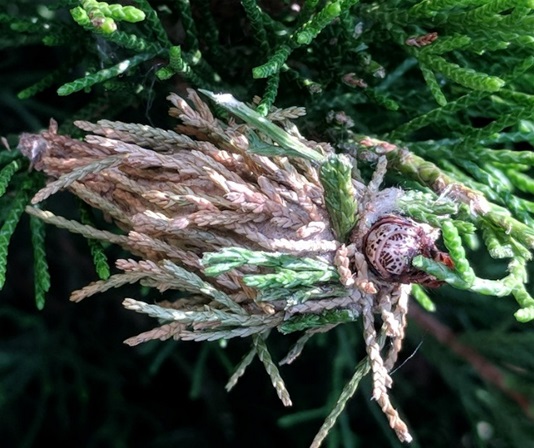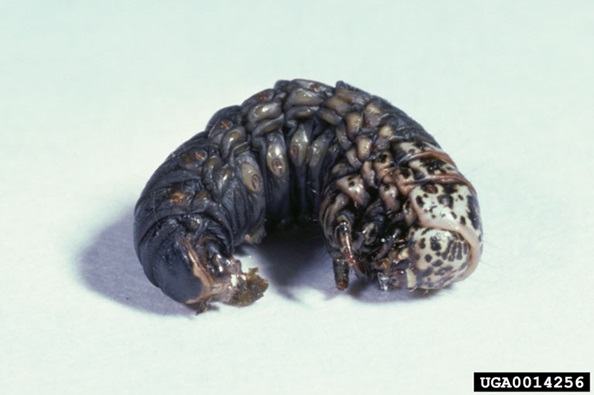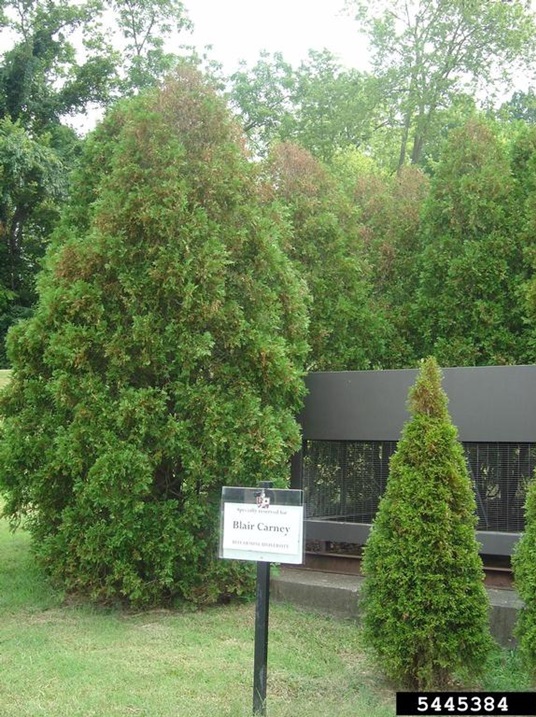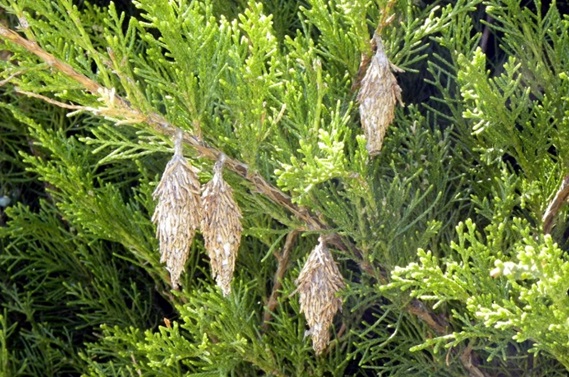Dealing with Bagworms on Landscape Plants
ENTFACT-440: Dealing with Bagworms on Landscape Plants | Download PDF
Jonathan L. Larson, Extension Entomologist
Fast Facts
- Bagworms (also known as common or evergreen bagworms) are caterpillar pests that construct a 1.5-2 inch long “bag” around their body using silk and materials from the plant they are feeding on.
-
While bagworms are commonly associated with evergreen plants such as juniper, arborvitae, spruce, and pine, they can also be found in deciduous hosts such as maple, oak, and locust trees.
-
Bagworms cause defoliation, which leads to thinning in the leaf canopy. Further, when they feed on evergreens, they can induce plant “bronzing”.
-
Management is dependent on catching the infestation early (in May or June) and using biorational insecticides such as Bt (Bacillus thuringeinsis), neem, or Spinosad. Older and larger bagworms (found in late summer) can be partially managed with synthetic insecticides like bifenthrin and carbaryl. Hand removal of bags is also effective.
Potential Hosts
Bagworms can feed on trees and shrubs from over 50 different families. Most issues are associated with evergreen plants. Some of their favorite evergreen hosts include juniper, arborvitae, red cedar, cypress, and pine. It should be noted that deciduous trees are not safe from bagworms though. The larvae can be found feeding in apple, birch, elm, locust, maple, oak, and willow trees amongst others.
Symptoms and Pest Description
Bagworms are leaf feeding pests as larvae. Early instar caterpillars create small holes in leaves or needles or may produce windowpane like feeding symptoms. As they grow, they will be able to feed on more of the leaves. They may completely defoliate an area of the plant, or they may leave behind the largest veins of the host leaf.
Figure 1: Inside of each bag is a caterpillar that feeds on the leaf materials in their host. The caterpillars are a mix of brown, white, and black. Here you can see the head protruding from the top of the bag so the caterpillar can feed. (Photo: Jonathan Larson, University of Kentucky)
Figure 2: A bagworm without its bag. Bagworms are dark in color with a mottled head cap. (Photo by: Gerald J. Lenhard, Louisiana State University, Bugwood.org)
Feeding damage from bagworms tends to start at the top of the host plant. As feeding progresses, the canopy of the tree or shrub will become thinner. Over successive generations, they will move down the plant and symptoms may spread. In evergreen hosts, the bagworm often induces “bronzing” a symptom where formerly green sections have become bronze or brown. These areas will likely never recover.
Figure 3: Bagworm damage most often starts at the tops of affected plants. On evergreens, a bronze color may be noticed in areas of heavy feeding (Photo by Jason Sharman, Vitalitree, Bugwood.org)
The most seen characteristic of bagworms is the bag itself. They have been described as pinecone like by some. When the caterpillar first emerges, the bag they construct is conical but as they mature, the bag may become more diamond shaped in profile. The bag is tough and brown and covered in material from the host plant like leaf bits, needles, and berries. Inside of the bag is the caterpillar which can range from 1/8th inch long to over an inch long depending on the instar of development. Caterpillars are mostly brown in color, with the head and thorax having stripes of yellow-white and black. Pupae are located inside of the bag and are dark brown. Males will emerge as winged moths which are small and brown with fuzzy antennae. Females on the other hand emerge as adults that resemble the caterpillar stage, they have no wings, reduced legs, and will never leave the bag.
Figure 4: Bagworm bags are built from insect silk and materials in the host tree. They are well camouflaged but can become more obvious in late summer when the bags are nearing 2 inches in length. (Photo: Jim Kalisch, University of Nebraska-Lincoln)
Life Cycle in Kentucky
Bagworm eggs begin to hatch in May across most of Kentucky. Upon hatching, the newly emerged caterpillar will either stay and reinfest the tree they were born in, or they may “balloon” away to a new site. Ballooning involves releasing a small strand of silk and using that to ride wind currents before landing on a new host.
The caterpillars will progress through seven instars of development. As they progress, the larvae will get larger and will also enlarge the bag they live in. After about 6-8 weeks of feeding, the larvae will be ready to pupate. Typically, this occurs in the early fall and the caterpillars pupate inside of the bag they have constructed. Sometimes the caterpillar will take its bag and leave the host plant before pupating, leading to bags being found on the exteriors of homes, on fences, and other odd locations.
Once pupation is complete, the winged males emerge to mate with the females inside of their bags. The females produce a pheromone that recruits males to their bag for mating to occur. Male moths live for a short period while females may live for 1-2 weeks as adults. Females lay their eggs in the remains of their pupal case, where those eggs will overwinter to emerge next year.
Management
Bagworms can cause enough damage over successive years to seriously harm trees and shrubs. One possible management strategy is to go to infested plants in the winter and snip the bags out of the plant. Use sharp scissors, shears, or a knife to cut the loop holding the bag to the plant. Following this procedure will remove the female bags with eggs and hopefully prevent an infestation in the spring.
If bagworms infestations are caught in May or June when the caterpillars are still small, biorational insecticides such as Bt (Bacillus thuringeinsis), neem, and Spinosad will manage populations. If the bagworms are not discovered until later in the season, then applications of pyrethroid insecticides (such as bifenthrin) or carbaryl may be needed to try and curtail the caterpillars. These likely won’t eliminate the population but would limit damage. If the infestation is localized to one plant, then the physical removal method mentioned before is an option late in the summer as well. Any bagworm bags removed while the caterpillar is alive should be thrown into a bucket of soapy water to kill the insect. Do not remove the bags and throw them on the ground around the tree, they will simply return to feed more!
Issued: 4/98, Revised: 01/22
CAUTION! Pesticide recommendations in this publication are registered for use in Kentucky, USA ONLY! The use of some products may not be legal in your state or country. Please check with your local county agent or regulatory official before using any pesticide mentioned in this publication.
Of course, ALWAYS READ AND FOLLOW LABEL DIRECTIONS FOR SAFE USE OF ANY PESTICIDE!
Images: University of Kentucky Entomology




